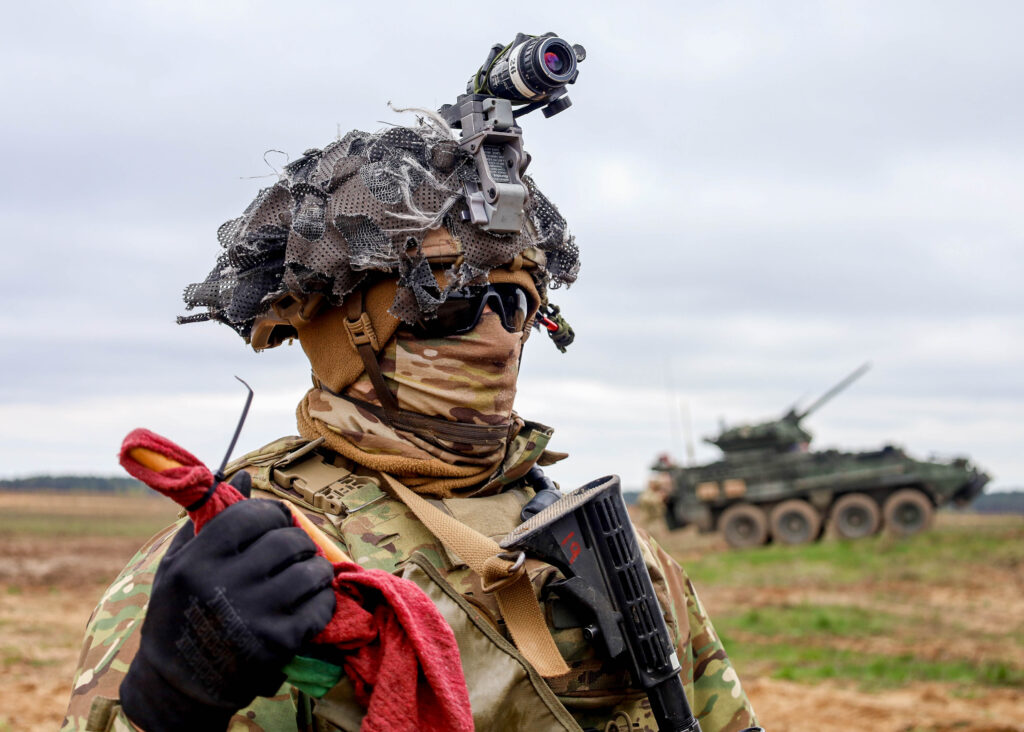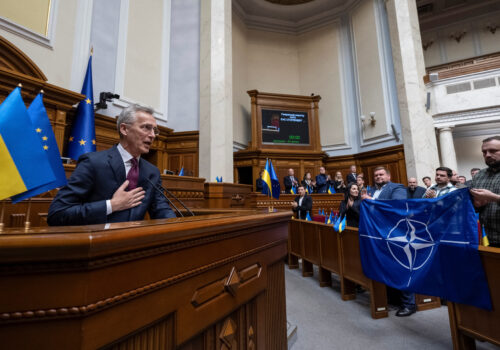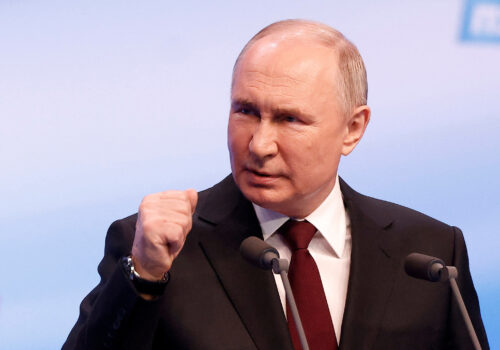For the last four months, NATO forces have staged the largest drills since the Cold War to rehearse defending their eastern flank against a Russian invasion. It’s the first time they’ve explicitly trained against Russia instead of an unnamed adversary. With Russia’s invasion of Ukraine and its explicit threats to conquer NATO allies, there’s little use in pretending otherwise.
This was the context of our trip to Lithuania and Belgium in late April for meetings with officials in Vilnius, NATO forces near the border with Russia, and European Union (EU) officials in Brussels working to bolster the continent’s defense. With crucial supplemental aid for Ukraine now passed by Congress, policymakers in the United States and across Europe should learn from the urgency with which frontline nations regard the threat of a Russian invasion.
Lithuania is all in when it comes to support for Ukraine’s victory. As NATO’s closest capital city to Minsk, Kyiv, and Moscow, Vilnius can’t afford complacency. US forces stationed at a newly built base near Pabradė, thirty miles northeast of the capital, laid out the stakes for us in shockingly plain terms: The territory captured by Russia in Ukraine during the first few weeks of its full-scale 2022 invasion is equivalent to more than half of the territory of the Baltic states—Lithuania, Latvia, and Estonia. Deterring a potential invasion of the Baltics is perhaps the most important objective for NATO today.
Russia’s war against Ukraine has made it clear that the Kremlin is comfortable pursuing maximalist war aims.
A close second is being prepared if deterrence fails. If Russia were to gear up for another major invasion, NATO would likely see it coming. The world watched for months in the winter of 2021-2022 as Moscow built up its forces around Ukraine. But NATO troops stationed today in Lithuania don’t have the fuel, ammunition, or manpower they would need to hold their ground in a worst-case scenario. At best, these US and Lithuanian troops currently have the capacity to repel a “minor incursion” by Russian troops.
But Russia’s war against Ukraine has made it clear that the Kremlin is comfortable pursuing maximalist war aims. NATO forces would likely need to evacuate before regrouping elsewhere, most likely Poland, before counterattacking. Should Russia capture the Suwałki Gap—the tight corridor between the Russian exclave of Kaliningrad and Belarus which links Lithuania to Poland—the Baltics would be all but encircled.
This is why Russia’s invasion of Ukraine is so existential for Lithuania—NATO’s plan is less to defend the Baltics than to retake them in the event that Russia launches another major land invasion. One look at the horrific war crimes uncovered in places like Bucha—buildings razed, civilians slaughtered in the streets, mass graves—shows why even a few weeks of occupation by Russian forces would pose a serious threat for Lithuanians.
Against this backdrop, the prospect of a second Trump administration in the United States raises concern in NATO’s eastern flank. In February, former President Donald Trump remarked that he “would encourage [Russia] to do whatever the hell they want” to allies who “didn’t pay” the equivalent of at least 2 percent of their gross domestic product (GDP) in defense spending. This threat raised the fear that the United States’ commitment to defend NATO allies—the critical factor deterring Russian President Vladimir Putin from widening his war beyond Ukraine—might not be so ironclad under Trump 2.0.
Of course, Lithuania and at least ten NATO allies are spending more than 2 percent of their GDP on defense, according to the latest figures from the Alliance. In 2023, Lithuania spent an estimated 2.5 percent of GDP, with the aim of reaching 3.5 percent, while the United States spent 3.5 percent. But 2023 figures also show that many countries in Western Europe are not meeting the 2 percent target, though Germany and France are on track to do so this year.
While the 2 percent threshold is a guideline, not a requirement, a lack of investment in defense has real implications for transatlantic security. European policymakers with whom we met in Brussels laid out the problem: Today, Europe alone does not have the industrial capacity to produce the materiel needed to defend the continent from a major Russian attack. Tepid economic growth, few incentives to entice companies to invest, lack of political will, and bureaucracy have all cut into the resources necessary to defend Europe should Russia embark on another aggressive military adventure.
The single best way to defend the Baltics is to ensure that Ukrainians get the tools they need to defeat Russia today.
As a result, countries such as Lithuania and Poland, which do see the urgent need for greater defense expenditure, often buy from the United States. This is good news for US manufacturers, but it raises interoperability concerns when countries try to integrate European and US systems, as well as concerns about US systems being expensive to purchase and maintain. “If we want to hit 3.5 percent of GDP on defense,” one Lithuanian official who requested anonymity told us, “we can buy lots of artillery shells or just a few F-35s.” European states that rely too heavily on the United States could risk failing to make necessary investments into Europe’s own defense industrial base. With the supplemental aid legislation recently passed by Congress injecting major new investments into the US defense sector, the clock is ticking for Europe to ramp up its own production.
To make up the gap, one EU policymaker, who requested anonymity to discuss sensitive matters, estimated that European allies would need to spend 3 percent of GDP on defense for the next several years, a prospect the official noted is likely untenable for a range of allies in Western and Southern Europe. Shaking whole countries from their complacency is no easy task when the Russian threat is comparably far away. While Trump’s comments in February unhelpfully raised concerns about the United States’ commitment to its allies, our conversations in Brussels suggested they may have also injected some urgency into defense discussions in Europe. July’s NATO Summit in Washington is an important opportunity for allies to announce a more energetic approach to collective defense.
In fact, the NATO Summit is an excellent platform for the United States and its NATO allies to coalesce around a strategy for victory in Ukraine. In almost every meeting with officials from Lithuania’s Ministries of Foreign Affairs and Defense, parliament, and presidential administration, we heard a serious desire for bolder US support for Ukraine and a more focused strategy for victory. While at a dinner with several Lithuanian officials, phones buzzing with news that long-range Army Tactical Missile Systems, known as ATACMS, had been sent to Ukraine elicited an immediate celebratory toast.
“We’re still waiting for the ‘Long Telegram,’” one Lithuanian official told us, referencing US diplomat George Kennan’s famous 1946 warning from Moscow painting the bigger picture for Washington about the threat represented by the Soviet Union. Kennan’s warning was the first real step toward crafting what would become Washington’s Cold War strategy of containment.
Tucked into the recently-passed supplemental aid package for Ukraine is a new requirement that the Biden administration deliver to Congress a strategy to “help hasten Ukrainian victory against Russia’s invasion forces in a manner most favorable to United States interests.” With Ukraine aid passed, this is the next big opportunity for the United States to show its allies that Washington is serious about Ukrainian victory.
NATO’s ongoing exercises will help the Alliance prepare for—and ideally deter—a potential Russian invasion of the Baltics. But one thing is clear from our conversations in Europe: The single best way to defend the Baltics is to ensure that Ukrainians get the tools they need to defeat Russia today, instead of NATO being forced to defend against Russia further down the line. That strategy is in progress in Europe, but it will require a clearer focus on victory from Washington and sustained investment from European capitals and manufacturers to become reality.
Andrew D’Anieri is a resident fellow at the Atlantic Council’s Eurasia Center.
Doug Klain is a policy analyst at Razom for Ukraine and a nonresident fellow at the Atlantic Council’s Eurasia Center.
Their trip to Brussels and Vilnius was organized and supported by the European External Action Service as part of its EU-US Emerging Leaders Programme.
Further reading
Wed, May 1, 2024
NATO chief urges long-term Ukraine aid as Russian army advances
UkraineAlert By Peter Dickinson
With Russian troops advancing in Ukraine, NATO Secretary General Jens Stoltenberg has accused alliance members of failing to provide Kyiv with promised aid and renewed calls for a reliable long-term response to Russian aggression, writes Peter Dickinson.
Sun, Apr 7, 2024
Western weakness in Ukraine could provoke a far bigger war with Russia
UkraineAlert By
Western leaders must decide whether they would rather arm Ukraine for victory today or fight a resurgent and emboldened Russia tomorrow, writes Oleksiy Goncharenko.
Thu, Mar 21, 2024
Russian victory in Ukraine would leave Europe at Putin’s mercy
UkraineAlert By
A Russian victory in Ukraine would reinvigorate Putin's war machine and leave much of Europe at the mercy of the Kremlin, writes Mykola Bielieskov.
Image: US Army Spc. Gage Green, an armored reconnaissance specialist part of 2nd Squadron, 2nd Cavalry Regiment, prepares to fly a signal flag during Saber Strike 24, Pabrade Training Area, Lithuania, April 21, 2024. Saber Strike 24 is the first in a series of exercises as a part of DEFENDER 24. The exercises are designed to deter adversaries, transform operational mission command, build readiness and strengthen the NATO alliance. (U.S. Army photo by Spc. Devin Klecan)



